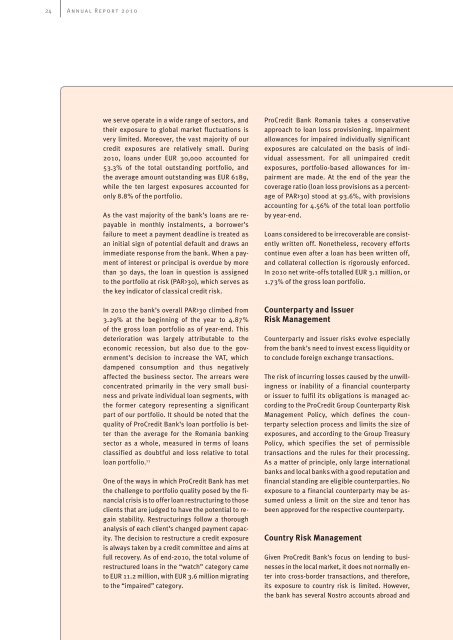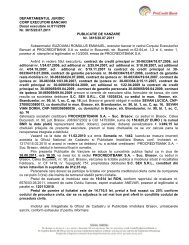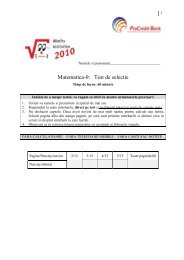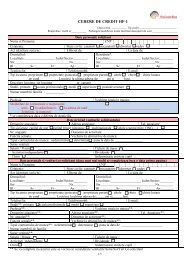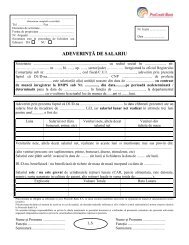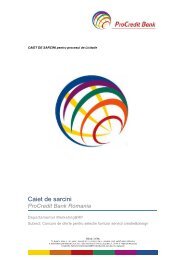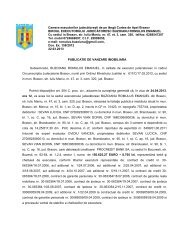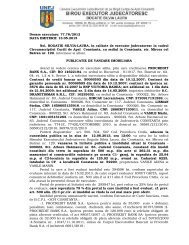Annual Report 2010 - ProCredit Bank
Annual Report 2010 - ProCredit Bank
Annual Report 2010 - ProCredit Bank
Create successful ePaper yourself
Turn your PDF publications into a flip-book with our unique Google optimized e-Paper software.
24<br />
<strong>Annual</strong> <strong>Report</strong> <strong>2010</strong><br />
we serve operate in a wide range of sectors, and<br />
their exposure to global market fluctuations is<br />
very limited. Moreover, the vast majority of our<br />
credit exposures are relatively small. During<br />
<strong>2010</strong>, loans under EUR 30,000 accounted for<br />
53.3% of the total outstanding portfolio, and<br />
the average amount outstanding was EUR 6189,<br />
while the ten largest exposures accounted for<br />
only 8.8% of the portfolio.<br />
As the vast majority of the bank’s loans are repayable<br />
in monthly instalments, a borrower’s<br />
failure to meet a payment deadline is treated as<br />
an initial sign of potential default and draws an<br />
immediate response from the bank. When a payment<br />
of interest or principal is overdue by more<br />
than 30 days, the loan in question is assigned<br />
to the portfolio at risk (PAR>30), which serves as<br />
the key indicator of classical credit risk.<br />
In <strong>2010</strong> the bank’s overall PAR>30 climbed from<br />
3.29% at the beginning of the year to 4.87%<br />
of the gross loan portfolio as of year-end. This<br />
deterioration was largely attributable to the<br />
economic recession, but also due to the government’s<br />
decision to increase the VAT, which<br />
dampened consumption and thus negatively<br />
affected the business sector. The arrears were<br />
concentrated primarily in the very small business<br />
and private individual loan segments, with<br />
the former category representing a significant<br />
part of our portfolio. It should be noted that the<br />
quality of <strong>ProCredit</strong> <strong>Bank</strong>’s loan portfolio is better<br />
than the average for the Romania banking<br />
sector as a whole, measured in terms of loans<br />
classified as doubtful and loss relative to total<br />
loan portfolio. 11<br />
One of the ways in which <strong>ProCredit</strong> <strong>Bank</strong> has met<br />
the challenge to portfolio quality posed by the financial<br />
crisis is to offer loan restructuring to those<br />
clients that are judged to have the potential to regain<br />
stability. Restructurings follow a thorough<br />
analysis of each client’s changed payment capacity.<br />
The decision to restructure a credit exposure<br />
is always taken by a credit committee and aims at<br />
full recovery. As of end-<strong>2010</strong>, the total volume of<br />
restructured loans in the “watch” category came<br />
to EUR 11.2 million, with EUR 3.6 million migrating<br />
to the “impaired” category.<br />
<strong>ProCredit</strong> <strong>Bank</strong> Romania takes a conservative<br />
approach to loan loss provisioning. Impairment<br />
allowances for impaired individually significant<br />
exposures are calculated on the basis of individual<br />
assessment. For all unimpaired credit<br />
exposures, portfolio-based allowances for impairment<br />
are made. At the end of the year the<br />
coverage ratio (loan loss provisions as a percentage<br />
of PAR>30) stood at 93.6%, with provisions<br />
accounting for 4.56% of the total loan portfolio<br />
by year-end.<br />
Loans considered to be irrecoverable are consistently<br />
written off. Nonetheless, recovery efforts<br />
continue even after a loan has been written off,<br />
and collateral collection is rigorously enforced.<br />
In <strong>2010</strong> net write-offs totalled EUR 3.1 million, or<br />
1.73% of the gross loan portfolio.<br />
Counterparty and Issuer<br />
Risk Management<br />
Counterparty and issuer risks evolve especially<br />
from the bank’s need to invest excess liquidity or<br />
to conclude foreign exchange transactions.<br />
The risk of incurring losses caused by the unwillingness<br />
or inability of a financial counterparty<br />
or issuer to fulfil its obligations is managed according<br />
to the <strong>ProCredit</strong> Group Counterparty Risk<br />
Management Policy, which defines the counterparty<br />
selection process and limits the size of<br />
exposures, and according to the Group Treasury<br />
Policy, which specifies the set of permissible<br />
transactions and the rules for their processing.<br />
As a matter of principle, only large international<br />
banks and local banks with a good reputation and<br />
financial standing are eligible counterparties. No<br />
exposure to a financial counterparty may be assumed<br />
unless a limit on the size and tenor has<br />
been approved for the respective counterparty.<br />
Country Risk Management<br />
Given <strong>ProCredit</strong> <strong>Bank</strong>’s focus on lending to businesses<br />
in the local market, it does not normally enter<br />
into cross-border transactions, and therefore,<br />
its exposure to country risk is limited. However,<br />
the bank has several Nostro accounts abroad and


